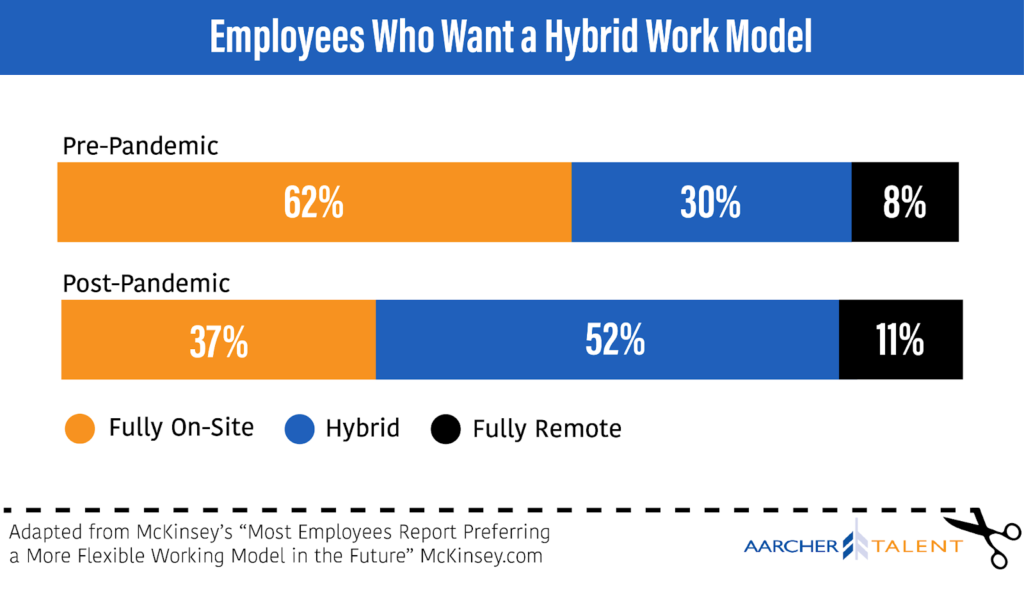This is Part 3 of 4 in the series “Hybrid Work in the EHS Industry.”

Hybrid work is a popular work strategy that is not going away and continues to grow in popularity. But is it the right choice for the EHS industry?

The Challenges with Hybrid Work
- Communication Concerns
- Social Connection Issues
- The Grass is Greener Situations
- Work-Life Imbalances
- Hybrid Work Ambiguity
Communication Concerns
Hybrid EHS workers are not always face-to-face with their co-workers, and many times, work in an asynchronous way. Different work schedules and even different time zones allow for communication that is not instantaneous as one person’s day has ended and another’s has not.
Additionally, small talk at the office has an important spot in workplace communication, in which a passing comment can stimulate a conversation around a topic that may not have otherwise been brought up. According to Forbes, “In-person communication is always superior when you are trying to promote dialogue versus just passing along information.” Additionally, 90% of communication comes from nonverbal communication, which doesn’t come across very well when a worker is not on-site.
Social Connection Issues
According to Harvard Business Review, hybrid work can also create a “dominant class of those who feel like they’re central to the organization and strongly committed to it and an underclass” of those who feel like they are on the periphery. They report not only feeling disconnected from work but also feeling like they are missing out on the social bonds that an in-person team forms.
The Grass is Greener Situations
Co-workers who have to work on-site may feel resentment toward the people who are allowed to work part of the time off-site. On the other hand, workers who work off-site may not be getting heard in the same way their on-site co-workers are. Additionally, on-site employees may be receiving more opportunities for promotions, and a fifth of surveyed workers felt like they received less recognition in the workplace compared to on-site co-workers.
Work-Life Imbalances
EHS employees may have faster burnout in a hybrid model due to dealing with working longer hours because there is no time clock to punch at home. There is also guilt they feel for taking time off in the morning to bring their child to the dentist, for example, and this guilt can lead to working late at night to make up those hours.
Hybrid Work Ambiguity
Due to hybrid work being a new term, it does not yet have an industry-standard definition, and as a result, it doesn’t have clearly defined rules to help companies navigate best operating practices.
For instance, business software company Qualtrics stated there is hybrid work and hybrid work from home. Hybrid work has the employee divide their time between home and the office. Hybrid work from home is when some employees are working off-site most of the time.
With hybrid work a continuing reality, it’s important to note that, while it has its benefits, it also comes with a list of concerns that EHS employers should take into consideration when developing their hybrid work strategies. In the upcoming final part of this series, Aarcher Talent will discuss how companies in the EHS industry can create an optimum hybrid model.
- Part 1: The Current State of Hybrid Jobs in the EHS Industry
- Part 2: Why Employers Should Offer More Hybrid Jobs in the EHS Industry
- Part 4: How to Create an Optimum Hybrid Model in the EHS Industry
Resources:
5 Challenges of Hybrid Work— and How to Overcome Them, Martine Haas, HBR.org.
8 Hybrid Work Challenges—and How to Overcome Them, Workplace.com.
13 Times In-Person Communication Is Better Than Electronic Exchanges,Forbes.com.
Hybrid Work: Definition, Tips and Strategies, Qualtrics.com.
Overcoming the Communication Gap for Hybrid Teams, LucidSpark.com.
The 7 Biggest Hybrid-Working Challenges, and How to Fix Them, Oliver Pickup, Worklife.news.
The Challenges of Hybrid Work, Tomas Chamorrow-Premuzic, Forbes.com.
What Are the Benefits and Disadvantages of the Hybrid Work Model? Maria Akhter, Envoy.com.